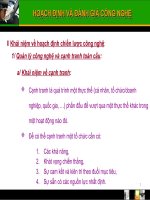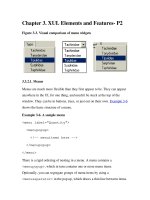chapter 3 mineral resources
Bạn đang xem bản rút gọn của tài liệu. Xem và tải ngay bản đầy đủ của tài liệu tại đây (4.61 MB, 73 trang )
Matter and Minerals
Minerals: Building blocks of
rocks
•
•
•
•
Naturally occurring
Solid
Inorganic
Definite chemical
composition
• Crystal structure due
to internal
arrangement of atoms
/>
General Facts about Minerals
• Between 2 - 3,000 have been identified
• A few are “native elements” -- made of only
one element, such as sulfur, gold. copper,
and graphite (carbon)
• Most are compounds, especially the silicate
group (Si, O).
• Other important groups are oxides,
carbonates, and sulfides.
Less than a dozen are common in
most rocks
• Quartz
• Feldspar (group)
• Muscovite (white
mica)
• Biotite (black mica)
• Calcite
• Pyroxene
• Olivine
• Amphibole (group)
• Magnetite, limonite,
and other iron oxides
• Pyrite
How do we identify minerals?
•
Physical properties:
Color
Luster
Hardness
Crystal shape
Cleavage
Specific gravity
Other
Physical Properties of Minerals
•
Color:
– Most obvious, but often misleading
– Different colors may result from impurities
Example:
Quartz
A mineral can be many different
colors. Below is Mica.
Many minerals can be the same color.
Below are gold colored minerals. Which
one is gold?
Physical Properties of Minerals
•
Color:
Streak – color of a mineral in powdered form
(used for metallic minerals)
Obtained by scratching
a mineral on a piece of
unglazed porcelain.
Example:
Hematite
Gold
• When gold is run
across a streak
plate it makes a
yellowish-gold
color.
Pyrite or “Fool’s Gold”
• When pyrite is run
across a streak
plate, it has a black
or dark green
streak.
• Pyrite is not worth
much money, while
gold is worth a lot.
They look alike, so
miners call it fool’s
gold.
Hematite
• Hematite’s color is
grey, but its streak
is red.
• Hema means
blood.
• The mineral was
named hematite
because it looked
like it was bleeding
when it was taken
across a streak
plate.
Physical Properties of Minerals
•
Luster:
– How a mineral surface reflects light
– Two major types:
• Metallic luster
• Non-metallic luster
Metallic
example:
Galena
Non-metallic
example:
Orthoclase
Pyrite has metallic luster
Quartz has vitreous luster
Physical Properties of Minerals
•
Hardness:
– How easy it is to scratch a mineral
– Mohs Scale of Hardness
• relative scale
• consists of 10 minerals, ranked 1 (softest)
to 10 (hardest)
Mohs Scale of Hardness
Hardest (10) – Diamond
Softest (1) – Talc
Common objects:
- Fingernail (2.5)
- Copper coin (3.5)
- Wire nail (4.5)
- Glass (5.5)
- Streak plate (6.5)
Gypsum is soft, it can be scratched by
a fingernail.
Calcite is soft, but a little harder
because it cannot be scratched by a
fingernail, but it can be scratched by a
coin
Fluorite is harder. It can be scratched
by a nail, but not a coin or fingernail.
Diamond is the hardest mineral, so
it scratches every mineral.
Physical Properties of Minerals
•
Crystal shape (or form):
– external expression of a mineral’s internal
atomic structure
– planar surfaces are called crystal faces
– angles between crystal faces are constant for
any particular mineral
Quartz
Pyrite
Physical Properties of Minerals
•
Cleavage vs. Fracture:
– The way a mineral breaks
– Cleavage: tendency of a mineral to break
along planes of weakness
– Minerals that do not exhibit cleavage are said
to fracture
Do not confuse cleavage planes with crystal faces!
Crystal faces are just on the surface and may not
repeat when the mineral is broken.
Physical Properties of Minerals
•
Cleavage is described by:
– Number of planes
– Angles between adjacent planes
– These are constant for a particular mineral
Physical Properties of Minerals
•
Cleavage (1 direction):
Example: mica









